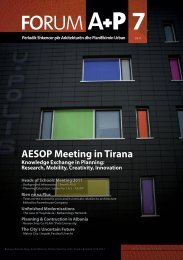Forum A+P 08
POLIS University publishes the “Forum A+P” journal, the only scientific and cultural magazine in the Albanian –speaking countries for the fields of architecture and territory planning. This magazine is recognized by the Ministry of Education and Science, the Academic Degrees Evaluation Committee and has an ISSN international registration code in France. The magazine is published in Albanian and English language and contains a package of scientific, informative articles and analysis.
POLIS University publishes the “Forum A+P” journal, the only scientific and cultural magazine in the Albanian –speaking countries for the fields of architecture and territory planning. This magazine is recognized by the Ministry of Education and Science, the Academic Degrees Evaluation Committee and has an ISSN international registration code in France. The magazine is published in Albanian and English language and contains a package of scientific, informative articles and analysis.
- No tags were found...
Create successful ePaper yourself
Turn your PDF publications into a flip-book with our unique Google optimized e-Paper software.
Auditorium Parco Della Musica Rome, 1994-2002<br />
Auditorium Parco Della Musica Rome, 1994-2002<br />
National Center for Science and Technology Amsterdam, 1992-1997<br />
National Center for Science and Technology Amsterdam, 1992-1997<br />
222<br />
putting yourself in the right state to create<br />
is even more difficult. You need peace and<br />
quiet, but also tension; calm, but energy too;<br />
time, but speed as well.” Piano hastened to<br />
add that the office is no hermitage, first of all<br />
because a lot of people from many different<br />
countries work there, and also because it<br />
communicates in real time with the rest of<br />
the world. Placed between the mountains<br />
and the sea, the workshop stands on terraced<br />
slopes, and is made almost entirely of glass,<br />
looking very much like the greenhouses that<br />
share hillsides in this part of the Riviera. The<br />
plants are inside and out, blending into the<br />
work spaces<br />
Colin Amery, Architectural Critic says,<br />
looking like a giant glass butterfly that has<br />
delicately landed on the cliff—this is the<br />
terraced studio that is part of the land and<br />
the sea. UNESCO scientists are growing<br />
bamboo and agave and cane on the ancient<br />
man made terrain and every one working in<br />
the studio is close to greenery and conscious,<br />
because of the glass and louvre roofs, of the<br />
changing quality of natural light. Although<br />
the studio environment is experimental<br />
it is also the safe harbour to which the<br />
adventurous architects and engineers return<br />
from their world-wide wanderings. Because<br />
of the continual advances in the technology<br />
of communication the workshop is in touch<br />
with the world. What Piano has called<br />
“technological ubiquity” makes the world<br />
smaller and simultaneously allows the<br />
possibilities of working close to nature.<br />
On the other side of the world in<br />
Noumea, New Caledonia, Piano is doing<br />
the Tjibaou Cultural Center, which he<br />
describes as “the most reckless of my many<br />
ventures into other fields.” He explained





